The Near-Patient Molecular Solutions Market is estimated to be valued at USD 4.1 billion in 2025 and is projected to reach USD 8.9 billion by 2035, registering a compound annual growth rate (CAGR) of 8.0% over the forecast period.
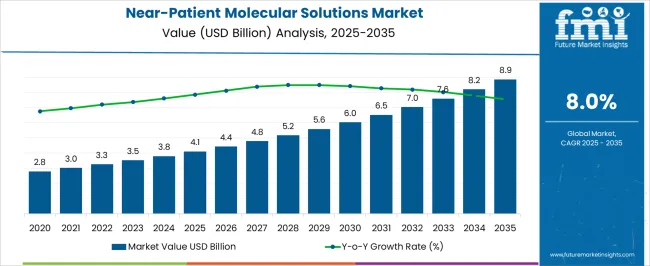
| Metric | Value |
|---|---|
| Near-Patient Molecular Solutions Market Estimated Value in (2025 E) | USD 4.1 billion |
| Near-Patient Molecular Solutions Market Forecast Value in (2035 F) | USD 8.9 billion |
| Forecast CAGR (2025 to 2035) | 8.0% |
The near patient molecular solutions market is experiencing accelerated growth due to the global push for faster diagnostics, personalized treatment protocols, and improved patient outcomes in acute care environments. Increasing prevalence of infectious diseases, combined with the growing need for decentralized and timely testing, has driven healthcare systems to invest in molecular platforms that can deliver results at the point of care.
Advances in miniaturized instrumentation, automated workflows, and multiplex assay formats are reshaping diagnostic strategies in clinical settings. The market is further propelled by rising healthcare expenditures, public health screening programs, and regulatory support for rapid molecular diagnostics.
As diagnostic technologies move closer to the patient, the market is poised for sustained expansion, with innovation and clinical integration expected to remain core to its future trajectory.
The market is segmented by Technology, Product Type, and End User and region. By Technology, the market is divided into PCR-based, Genetic Sequencing Based, Hybridization-based, and Microarray-based. In terms of Product Type, the market is classified into Infectious Diseases Testing Kits, Cardio-Metabolic Monitoring Kits, Pregnancy and Fertility, Coagulation Monitoring Kits, Hematology Testing Kits, Urinalysis Testing Kits, Glucose Monitoring Kits, Drugs-of-abuse Testing Kits, Testing Kits, Fecal Occult Testing Kits, Tumor/Cancer Markers, Cholesterol Test Strips, and Other Products. Based on End User, the market is segmented into Hospitals, Homecare, Diagnostic Laboratories, and Research Laboratories. Regionally, the market is classified into North America, Latin America, Western Europe, Eastern Europe, Balkan & Baltic Countries, Russia & Belarus, Central Asia, East Asia, South Asia & Pacific, and the Middle East & Africa.
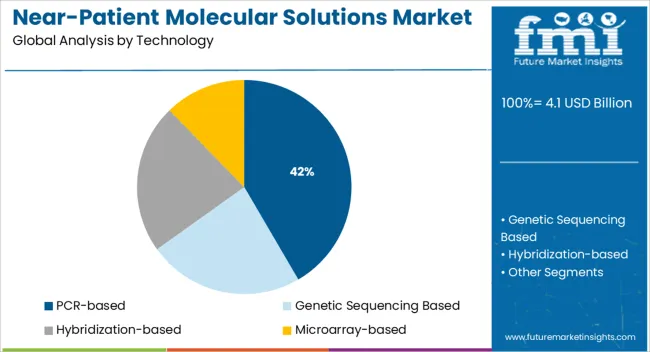
The PCR based segment is anticipated to represent 41.60% of total market revenue by 2025 within the technology category, establishing it as the dominant segment. This is driven by its unparalleled sensitivity and specificity in detecting low levels of viral and bacterial genetic material.
Its rapid amplification capabilities enable timely diagnosis, which is critical for infection control and treatment initiation. PCR based systems have also evolved into portable and fully automated platforms suitable for near patient settings, reducing reliance on centralized laboratories.
Their adaptability to emerging pathogens and broad assay availability make them essential tools in both routine diagnostics and outbreak response, reinforcing their leading position in the technology landscape.

The infectious diseases testing kits segment is projected to capture 48.30% of total market revenue by 2025 under the product type category, making it the most prominent segment. This growth is fueled by the continued global burden of infectious diseases such as respiratory infections, sexually transmitted infections, and gastrointestinal illnesses.
Rapid and accurate detection of pathogens at the point of care is essential to prevent transmission, manage treatment, and reduce hospitalizations. These kits offer convenience, speed, and reliability, supporting their integration into emergency departments, outpatient clinics, and primary care settings.
The emphasis on pandemic preparedness and routine infectious disease screening has elevated the relevance of this product type, consolidating its leadership in the market.
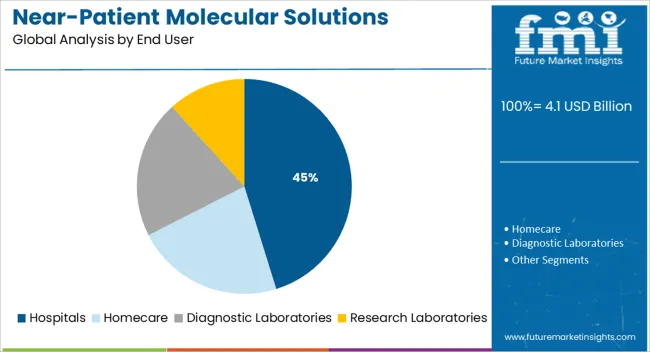
The hospitals segment is forecasted to contribute 45.20% of total market revenue by 2025 within the end user category, positioning it as the dominant channel for near patient molecular solutions. This is attributed to hospitals’ ability to rapidly adopt and deploy advanced diagnostic technologies due to higher patient throughput, infrastructure availability, and skilled personnel.
Near patient solutions in hospitals enable prompt diagnosis in emergency rooms, intensive care units, and surgical wards, where rapid clinical decisions are critical. Additionally, the integration of these diagnostics into electronic health systems allows for streamlined workflows, better case management, and improved patient outcomes.
With infection control and diagnostic efficiency being core operational goals, hospitals continue to lead in adopting molecular solutions that support timely and precise care delivery.
The growing end-use sectors such as hospitals, home care, diagnostic laboratories, and research laboratories increase the market expansion during the forecast period. However, the market for near-patient molecular solutions increased from USD 2.8 Billion between 2020 and 2025 with an impressive CAGR of 7.5%.
The rising improvement in healthcare devices and Smart applications with AI technology increases the adoption of near-patient molecular solutions. The key companies are paying attention to advancing the values of the near-patient molecular solutions market to provide effective treatment.
Short Term (2025 to 2025): The healthcare industry is growing by adopting Smart devices, IoT, and robotic systems expected to boost market expansion.
Medium Term (2025 to 2035): Growing rapid urbanization, data monetization, and increasing R&D activities are likely to drive the market.
Long Term (2035 to 2035): The top healthcare sector stimulates cloud computing technology and real-time data to exchange information leading to market expansion during the forecast period.
The global near-patient molecular solutions market is anticipated to be valued at USD 8.9 Billion by 2035 with a CAGR of 8%.
By technology, the market is segmented into PCR (Polymerase Chain Reaction) based, Genetic sequencing-based, hybridization-based and microarray-based. The PCR-based segment dominates the global market by contributing a significant role during the forecast period.
The rising adoption of polymerase chain reaction technology to treat a patient is anticipated to boost the market expansion during the forecast period. The increase in the innovation of molecular diagnostic devices is likely to rise the demand for polymerase chain reaction technology.
By product type, the market is classified into cardiometabolic monitoring kits, infectious diseases testing kits, coagulation monitoring kits, pregnancy and fertility, and hematology testing kits. Infectious disease testing kits dominate the global market by capturing a relevant share during the forecast period. The growing prevalence of diseases such as SARS COV-19 is likely to increase the demand for infectious disease testing kits during the forecast period.
By end-use segment, the hospital's category dominates the market by occupying the highest share during the forecast period. Due to the rising number of patients treating their infectious diseases such as chronic, diabetes, and other diagnostic treatment during the forecast period. In addition, homecare, research laboratories, and diagnostic laboratories are other remaining categories that contribute a significant role in the market growth.
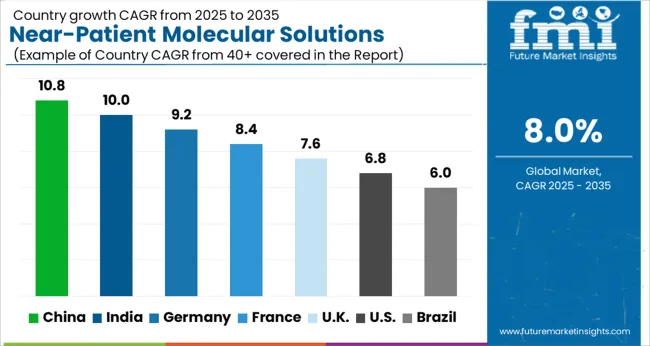
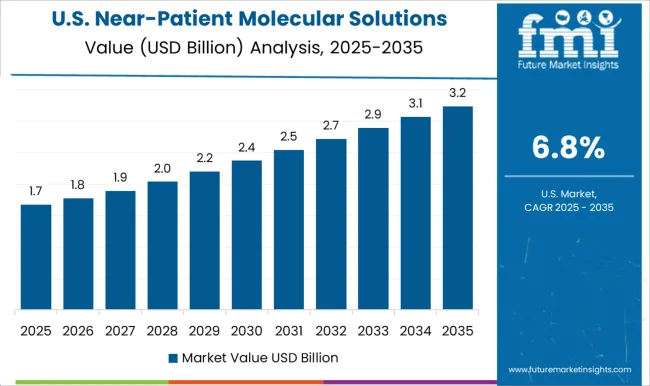
North America dominates the global market by securing a significant share during the forecast period. The USA is leading the global market with a rising number of clinical studies and good reimbursement policies for diagnostic procedures during the forecast period. In addition the growing demand for near-patient testing devices and the presence of prominent players increasing the market expansion during the forecast period.
The growing government support and investment among key companies are accelerating the demand for near-patient molecular solutions during the forecast period. However, the USA anticipated uplifting the market size with its new technologies and advanced healthcare infrastructure in the coming years.
The United Kingdom is anticipated to secure a significant share of the global market during the forecast period. The United Kingdom market has recently benefited from the increased availability of cutting-edge central laboratories for testing and well-known manufacturers.
The growing advanced automatic molecular testing device and research operation in the United Kingdom are increasing the market opportunities during the forecast period. In addition, rising well-equipped hospitals and a rising generic population are expected to drive the market share in recent years.
The Asia Pacific Region is advancing global marketing by capturing a significant share during the forecast period. The Asia Pacific is the fastest-growing region that rapidly expanding its market size in recent years. The rising disposable income and rapid urbanization are accelerating the demand for near-patient molecular solutions during the forecast period.
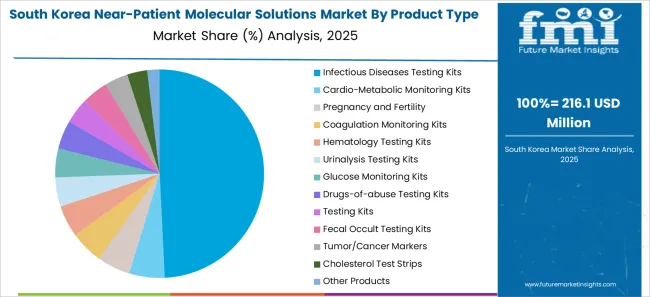
| Asian-countries | Korea |
|---|---|
| Driving Factors | The Korean nation is contributing a prominent role in the upsurge of the market size due to an increase the infectious diseases, a large patient population, and advanced healthcare equipment. The growing key healthcare manufacturers and development in the healthcare sector are surging the Korean near-patient molecular solutions market opportunities during the forecast period. |
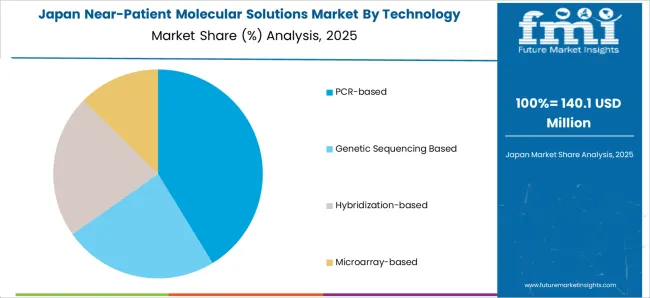
| Asian-countries | Japan |
|---|---|
| Driving Factors | Japan is another nation in the region that contribute a prominent role in the global market during the forecast period. Rising rapid flue testing devices and innovations in the healthcare industry are accelerating the demand for near-patient molecular solutions during the forecast period. |
How are Start-up Companies Experimenting in the Near-patients Molecular Solutions Market?
| Company Name | Sherlock Biosciences |
|---|---|
| Founded Year | 2020 |
| Description | Sherlock Biosciences is a near-patient molecular solution USA-based start-up company founded in 2020. The start-up provides synthetic biology and improves the patient's health from the diagnostic. The company aims to provide better diagnostics treatment to the patient with faster, more effective, and affordable tests. They are advancing molecular testing devices to offer better diagnostic solutions. |
| Company Name | Nucleai |
|---|---|
| Founded Year | 2020 |
| Description | Nucleai is an Israel-based start-up company that provides AI-powered healthcare applications to clinicians and pharmaceutical companies. The start-up enhances the support of treatment and drug development with biomarker discovery technology. They are developing a better understanding of cancer biology, improving patient healthcare, and optimizing with real-world pathology and molecular datasets. The company is a campaign across the nation to raise awareness among patients and improve patients' health with the best diagnostic tools. |
| Company Name | Yemaachi Biotechnology |
|---|---|
| Founded Year | 2024 |
| Description | Yemaachi Biotechnology is an Africa-based Cancer research start-up company that redefined cancer-diagnosed treatment with their innovative and suitable biomedical research. The start-up provides advanced medical treatment across the nation with its research and development activities. The company partnered with the biotechnology and pharmaceutical industries to develop advanced therapeutics and molecular diagnostics with novel technology. The company also provides clinical services such as molecular cancer test services with prognostiC testing and NGS-based screening. |
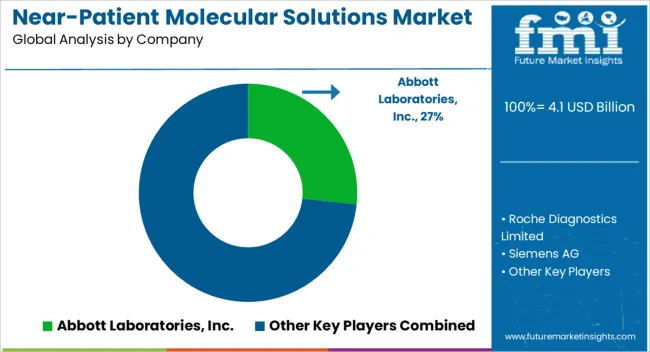
The market is consolidated by the number of prominent vendors in the region during the forecast period. Prominent vendors play a crucial role in the healthcare field to uplift the market size during the forecast period. These players are focusing on fulfilling the consumer's requirements as per their demand in recent years.
The prominent vendors are making several marketing strategies to acquire a lion’s share of the market. Innovating the relevant products through their research and development activities increases the market opportunities during the forecast period. Some of the marketing tactics adopted by these players include collaborations, partnerships, mergers, acquisitions, agreements, and product launches.
Recent Developments in the Driving Training Simulator Market
The global near-patient molecular solutions market is estimated to be valued at USD 4.1 billion in 2025.
The market size for the near-patient molecular solutions market is projected to reach USD 8.9 billion by 2035.
The near-patient molecular solutions market is expected to grow at a 8.0% CAGR between 2025 and 2035.
The key product types in near-patient molecular solutions market are pcr-based, genetic sequencing based, hybridization-based and microarray-based.
In terms of product type, infectious diseases testing kits segment to command 48.3% share in the near-patient molecular solutions market in 2025.






Full Research Suite comprises of:
Market outlook & trends analysis
Interviews & case studies
Strategic recommendations
Vendor profiles & capabilities analysis
5-year forecasts
8 regions and 60+ country-level data splits
Market segment data splits
12 months of continuous data updates
DELIVERED AS:
PDF EXCEL ONLINE
Molecular Diagnostic Market Size and Share Forecast Outlook 2025 to 2035
Molecular Respiratory Panels Market Size and Share Forecast Outlook 2025 to 2035
Molecular Diagnostics In Pharmacogenomics Market Size and Share Forecast Outlook 2025 to 2035
Molecular Biomarkers For Cancer Detection Market Size and Share Forecast Outlook 2025 to 2035
Molecular Cytogenetics Market Size and Share Forecast Outlook 2025 to 2035
Molecular Biology Enzymes, Kits & Reagents Market Trends and Forecast 2025 to 2035
Molecular Spectroscopy Market Insights - Growth & Forecast 2025 to 2035
Molecular Breast Imaging Market – Trends & Forecast 2025 to 2035
Molecular Quality Controls Market Overview - Trends & Forecast 2025 to 2035
Molecular Imaging Market is segmented by modality type, application and end user from 2025 to 2035
Molecular Microbiology Market
Low Molecular Weight Chondroitin Sulfate Sodium Market Size and Share Forecast Outlook 2025 to 2035
13X Molecular Sieve Activated Powder Market Size and Share Forecast Outlook 2025 to 2035
High Molecular Ammonium Polyphosphate Market Size and Share Forecast Outlook 2025 to 2035
Orthomolecular Medicine Market
Viral Molecular Diagnostics Market Size and Share Forecast Outlook 2025 to 2035
At-home Molecular Testing Market Size and Share Forecast Outlook 2025 to 2035
Airborne Molecular Contamination Control Services Market Forecast and Outlook 2025 to 2035
Automated Molecular Diagnostics Testing System Market Size and Share Forecast Outlook 2025 to 2035
Multiplex Molecular Diagnostics Market Size and Share Forecast Outlook 2025 to 2035

Thank you!
You will receive an email from our Business Development Manager. Please be sure to check your SPAM/JUNK folder too.
Chat With
MaRIA